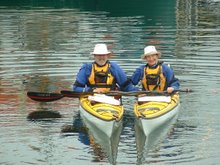After getting to bed around 2330, we were awake at 0100 for our approach into Kristiansund in the semi-dark. It was a relatively short night for us. We were up at 0600 to watch the scenery as we headed to Trondheim, well noted as the departure point for many Viking expeditions in the past. The first ever export of goods to Europe from North America took place here about 1000 years ago.
Since we were not sure how much time we will have when we drive south, we decided to join the excursion ashore to visit the Nidaros Cathedral, the Musikkhistorisk Museum at Ringve, and to see some of the local sights.
The cathedral is the only surviving cathedral in Norway, so it has great national and cultural importance. Although Norway was unified in 872 AD by Hakon Hakonsson with the defeat of the local chieftains by the people of Trondelag, it was Olaf who brought Christianity to the Vikings following his service to many lords in the Middle East. In the battle of Stiklestad in 1030, which was part of the struggle to force Christianity on the Vikings, Olaf was killed. Following his death, pilgrims traveled to see and be healed by St. Olav’s shrine. In 1152, an archbishop was appointed, and as a result, a more prestigious church was needed. Construction of the predominantly Gothic cathedral (early parts are Romanesque) began in 1170 on top of St. Olav‘s holy shrine, and was completed in about 1300. The cathedral remained one of Europe’s most important places of pilgrimage until the Reformation in 1537.
The Ringve Museum is the location of the Norwegian national museum of music and musical instruments. Our tour through the museum was amazing. We saw many beautiful old instruments dating back to the 15th and 16th centuries. There were early violas and cellos with 6 to 14 strings, rather than the 4-stringed version with which we are familiar. There were many Hardanger fiddles, a traditional Norwegian folk instrument, with 8 strings (4 conventional, plus 4 resonating) which apparently can have more than 30 different tunings. The museum has an amazing number of harpsichords, clavichords, and ancient pianos and organs. Our guide was a talented young musician who was extremely knowledgeable about all of the instruments. He also played many of the old instruments … amazing and delightful! This was definitely a highlight.
Our ship left port at 12:00 noon and eventually headed north along the coast passing farming communities and lighthouses. We sailed through a myriad of small islands and skerries and into the Froya and Halten areas known for many years for their fishing banks to the west. The Halten bank is more recently known for its oil and gas fields. The highlight of the afternoon was near Stokkoya when the ship entered a narrow channel about twice the width of the ship, made a sharp turn to starboard under a beautiful curved sweeping bridge on the coastal highway and then, sounding it’s horn, made a hard turn to port through an even tighter passage! It was amazing and leaves one in awe of the skill of these captains. The rest of the trip we passed by picturesque islands on either side, many with fish farming operations. We then headed out into an open stretch of sea as we made our way to Rorvik, our next port of call. Most of our day was been under sunny skies with just enough clouds to make them interesting. The wind remains cold however so we have been happy to have our mountain parkas. Sunset was about 2234.
After supper, we conversed with our dinner mates until near midnight in broken French and English … and hand waving. It turns out that Yvonne and Heintz live Nice during the winter, and Bavaria during the summers.
Thursday, May 31, 2007
Subscribe to:
Post Comments (Atom)

1 comment:
Hello to you both:
It sounds like you are very taken by the beauty and the history of the area. Can't wait to see some of the photos. Very cool!
Gary
Post a Comment